This section will cover:
- Introduction
- Field List
- Rows and Columns
- Drag and Drop with Fields
- Introduction to Table View Functions
- Knowledge Check
This section will cover:
The learning objectives for this page are:
In this section ‘All about Tables’, we will explore all things tables within Stat-Xplore for you to gain a greater, more comprehensive understanding of how to use Table View. The subsections within this section are organised based on what you see within Table View. Subsections labelled with ‘(Advanced)’ are features of Stat-Xplore that are beneficial but not essential for the everyday user.
Feel free to browse and read whatever is relevant to you or read the whole section. If you do, we recommend that you read it in order as it has been designed to optimise your learning experience.
Once you have opened a specific table from Stat-Xplore (for more information please visit 'Understanding the Home Page'), Stat-Xplore displays the Table View.
In Table View, you can:
If you decide to start creating a table from scratch, you may either see an empty table if the dataset doesn't contain a mandatory field or a pre-populated table with the mandatory field.
Below is an example of what you may see:

In this screenshot, the section on the left-hand side shows a list of available fields and field values that you can add to the table. For more information, please refer to the subsection 'Field List' below.
The area on the right-hand side is where your table is displayed. Unless you selected a saved table, this area will usually not contain any fields when you first open a dataset. The exception to this is if the database contains a mandatory field or a default table. If this is the case, the table will appear in the section on the right even if you clicked New Table or double-clicked a dataset. Within this table, you can add fields to the table and make other changes but you cannot remove the mandatory fields from the table.
If you decide that you wanted to switch working with a different dataset instead,
However, please note that switching to another dataset or table will clear the current table. if you think you might want to use the table you were working with again, you may wish to consider using the 'Save ’ button.
When you access Table View in Stat-Xplore, you can see a list of all the available fields on the left hand-side.
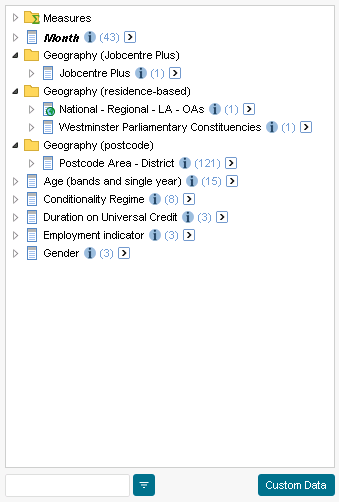
In this field list, items in the list have different icons so you can tell what they represent.
Here is what these icons mean:
 |
A field list. This is a menu that shows the available values (variables) such as 'Gender' or 'Age (bands and single year)'. Click the field or its icon to see the available field items. |
 |
A mappable field list. If you add this field to the table you will be able to access Map View. |

| An individual value within a field. If this field is a hierarchy, then you can click the field item to see the values at the next level in the hierarchy. |
 |
A group of fields. Its function is similar to a folder. Click to expand the group. |
 |
A group of measures. |
Next to the field list is where you can interact and craft your table on Stat-Xplore. Typically, basic tables only have fields in the rows and columns.
For example, in the example screenshot below, the ‘Duration on Universal Credit’ field is in the Vertical columns, and the ‘Gender’ field is in the horizontal rows:
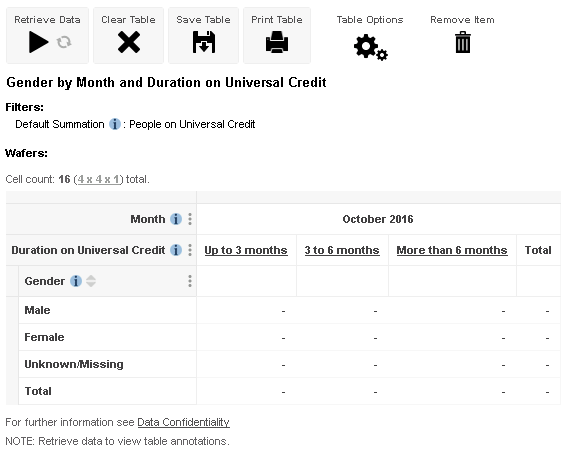
With these fields, if you want to manipulate them by swapping the columns and rows, you can simply drag and drop the field names from within the table.
For example:

This adds the field 'Age' to the row headings.
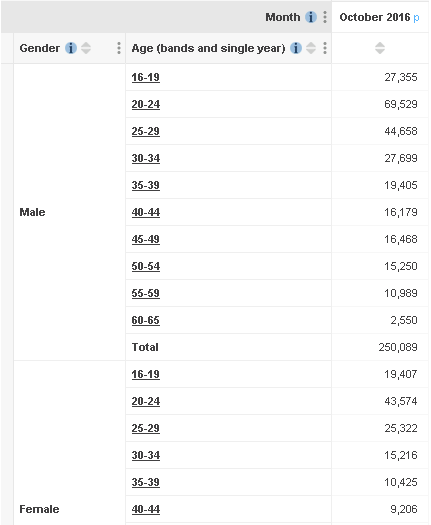
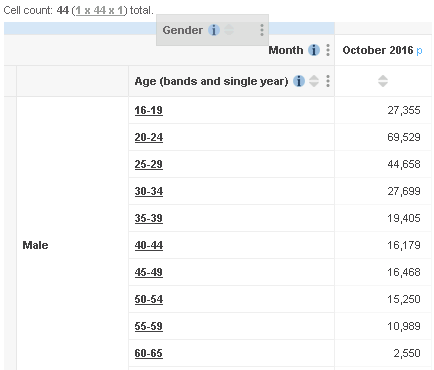
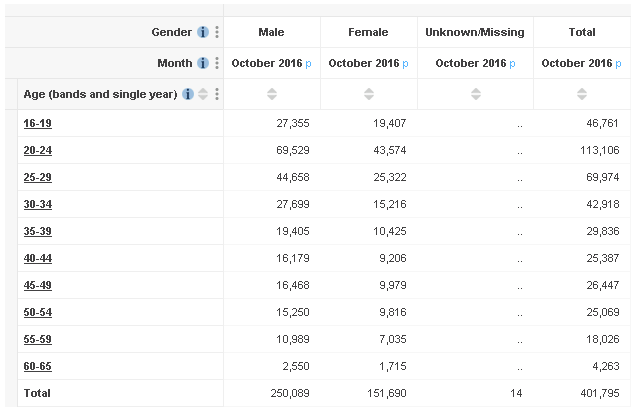
Within Table View in Stat-Xplore, there are a variety of different functions you can use to further customise your experience in Stat-Xplore. For example, to create or update a table, you can select the fields you want from the list and add them to either the table wafers, or filters. For further information, please refer to 'Basic Table View Functions' and its subsections.
If you still have any questions that are not answered in the guide, please feel free to email Stat.Xplore@dwp.gov.uk
What is the difference between a field list and a mappable field list?
A. A field list access to the Map View only and a mappable field list shows available values only
B. A field list shows available values only and a mappable field list shows access to map view only
C. A field list shows available values and access to the Map View and a mappable field list shows available values only
D. A field list shows available values only and a mappable field list shows available values and access to the Map View